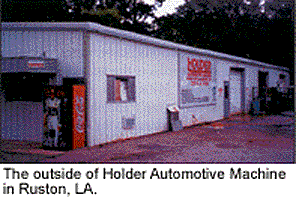According to a new market research study released by the Automotive Aftermarket Industry Association (AAIA), the Do-It-Yourself (DIY) segment of the automotive aftermarket is not shrinking; in fact, the percentage of DIYer households in the United States has remained constant for the past six years.
This comes as no surprise to Ernie and Sandi Holder, owners of Holder Automotive Machine in Ruston, LA. They say their customer base still consists mainly of the DIYer. Recovering from slow turnaround times experienced by the former owners, the Holders say that word of mouth can make or break a machine shop.

EB: How did the business get started?
SH: Our business started in 1988 and was originally owned by Bill and Peggy Ward. The name of the business at the time was Ruston Machine Works, and Ernie was their very first employee. They opened the business with very little equipment













